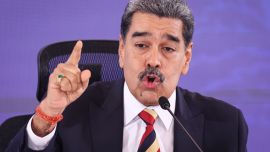Latin American policymakers who led the world into aggressive interest rate hikes after the pandemic are now warning investors that their battle against inflation will take longer than expected.
Brazilian and Chilean officials said during the International Monetary Fund’s Spring Meetings they still need more proof that price pressures are easing before cutting borrowing costs. Peru central bank head Julio Velarde didn’t mince words, saying “the worst case scenario for a central banker is to lower the interest rate only to hike it again two or three months later.”
Put together, in both closed-door and public events during a week of high-profile meetings in Washington, the region’s top economic authorities threw cold water over hopes of an imminent end to tight monetary policy. On the contrary, their message to developed economies was clear: bringing inflation back to their targets will be a long and messy battle.
“Central bankers are now telling the market to be patient, as they have to hold rates higher,” Ernesto Revilla, head of Latin American economics at Citigroup Inc., said during the meetings. “They are in a wait-and-see mode.”
The message marks a sharp turnaround from the previous round of IMF meetings in October, when regional delegations were celebrating declining expectations for consumer-price increases. Unlike the developed world, they were hoping that disinflation was just around the corner.
Still, Chile is now holding borrowing costs steady at an over two-decade high, while Brazil has one of the world’s steepest real rates. Mexico and Colombia are refusing to call an end to their tightening campaigns. Though an outlier, Argentina saw its annual inflation rocket to 104.3 percent, the highest level since 1991.
Around the region, core measures of inflation that strip out volatile items like food and energy are still accelerating, making it harder to cut rates without the risk of having to reverse course and lift them again.
Latin America’s inflationary pressures are getting an additional jolt from a backdrop of steadily higher borrowing costs in the world’s main economies.
“The disinflation process will be even more gradual than in developed countries,” said Martin Castellano, head of Latin America research at the Institute of International Finance.
Constraints
Regional central bankers are doubling down on their fight against inflation even as some heads of state criticise policymakers’ positions. In Brazil, President Luiz Inácio Lula da Silva has called monetary policy “irresponsible,” “incoherent” and even “absurd.” Colombia’s Gustavo Petro has said the central bank’s actions are failing to curve inflation.
To be sure, Latin American central bankers highlighted last week that credit flows are slowing down as they expect. Households are struggling with indebtedness and new loans to companies are stalling.
Many countries are also facing drastic weather events that hinder activity, pushing authorities to find alternative sources of financing.
Argentina’s drought is proving more severe than expected, according to IMF officials, and the government is looking to rework its debts with the Fund. Ecuador is looking for a US$1-billion loan from the organisation to face the consequences of floods. Countries like Uruguay are pushing for climate-focused lending from multilateral institutions like the World Bank.
“Right now we are in a time of constraints,” said William Maloney, the World Bank’s chief economist for Latin America. There are long-standing gaps that “need to be redressed” in infrastructure, education and health, he said.
“The region has some structural issues to deal with, and it can’t make a big dent in poverty at growth rates of around two percent” as most multilateral organisations expect, he said.
related news
by María Eloisa Capurro, Bloomberg





















Comments